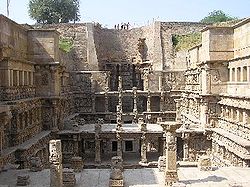
Rani ki vav
Encyclopedia

Stepwell
Stepwells, also called bawdi or baoli , or vaav are wells or ponds in which the water can be reached by descending a set of steps. They may be covered and protected, and are often of architectural significance...
situated in Patan
Patan, Gujarat
Patan was a capital of Gujarat in medieval times. It is the administrative seat of Patan District in the Indian state of Gujarat and administered by municipality. The city contains many Hindu and Jain temples as well as few mosques, dargahs and rojas...
town in Gujarat in India
India
India , officially the Republic of India , is a country in South Asia. It is the seventh-largest country by geographical area, the second-most populous country with over 1.2 billion people, and the most populous democracy in the world...
.
Patan was called as Anhilpur Patan when King Siddharja Jaysingh was ruling & it was the capital of Gujarat. Mr. Vanraja Chavda has founded Patan. During the period of the Solanki
Solanki
The Solanki was a royal Hindu Indian dynasty that ruled parts of western and central India between the 10th to 13th centuries. A number of scholars including V. A. Smith assign them Gurjar origin....
or Chalukya, the stepwell
Stepwell
Stepwells, also called bawdi or baoli , or vaav are wells or ponds in which the water can be reached by descending a set of steps. They may be covered and protected, and are often of architectural significance...
called the Rani ki vav, or Ran-ki vav (Queen’s step well) was constructed. It is a richly sculptured monument.
It is generally assumed that it was built in the memory of Bhimdev I
Bhimdev I
Bhimdev I was a Solanki ruler who ruled between 1021 AD and 1063 AD. He was son of Durlabhraj's brother Nagraj . Bhimdev's mother was Laxmidevi, a princess of Chauhan of Naddul. Bhimdev I ruled from the city of Anhilwara which was regarded as one of the largest cities in the world then...
(AD 1022 to 1063) son of Mularaja, the founder of the Solanki
Solanki
The Solanki was a royal Hindu Indian dynasty that ruled parts of western and central India between the 10th to 13th centuries. A number of scholars including V. A. Smith assign them Gurjar origin....
dynasty of Anahilwada Pattan in about 1050 AD by his widowed queen Udayamati.

Karandev I
Karandev I was a Solanki ruler credited with laying the foundation of the city of Karnavati, an old name for the city of Ahmedabad in western India. He waged a successful war against the Bhil king of Ashaval and soon after the victory established Karnavati on the banks of the Sabarmati river at the...
after his death. A reference to Udayamati building the monument is in the 'Prabandha Chintamani' composed by Merunga Suri in 1304 AD.
This magnificent east facing step well measures approximately 64m long, 20m wide & 27m deep. A stepped corridor compartmented at regular intervals with pillared multi-storeyed pavilions is a unique feature. It was one of the largest and the most sumptuous structures of its type. It became silted up and much of it is not visible now, except for some rows of sculptured panels in the circular part of the well. Among its ruins one pillar still stands which is the proof not only of the elegance of its design, but also excellent example of this period. A part only of the west well is extant from which it appears that the wall had been built of brick and faced with stone. From this wall project vertical bracket in pairs, this supported the different galleries of the well shaft proper. This bracketing is arranged in tires and is richly carved. The minute and exquisite carving of this vav is one of the finest specimens of its kind. Befitting its name, the Rani-Ki-Vav is now considered to be the queen among step wells of India.
There is also a small Gate below the last step of the step well which is having a 30 kilometre tunnel built (Now its has been blocked by stones and mud) which leads to the town of sidhpur near patan. It was used as an escape gateway for king who built the step well in the times of defeat.
Rani-ki-Vav (The Queen's Stepwell) at Patan, Gujarat is part of the UNESCO World Heritage Tentative List (since 1998).
Ornate side walls
Most of the sculpture are in devotion to VishnuVishnu
Vishnu is the Supreme god in the Vaishnavite tradition of Hinduism. Smarta followers of Adi Shankara, among others, venerate Vishnu as one of the five primary forms of God....
, in the forms of Dus-Avatars Kalki
Kalki
In Hinduism, Kalki is the tenth and final Maha Avatar of Vishnu who will come to end the present age of darkness and destruction known as Kali Yuga. The name Kalki is often a metaphor for eternity or time...
, Rama
Rama
Rama or full name Ramachandra is considered to be the seventh avatar of Vishnu in Hinduism, and a king of Ayodhya in ancient Indian...
, Mahisasurmardini, Narsinh, Vaman, Varahi
Varahi
Varahi is one of the Matrikas, a group of seven or eight mother goddesses in the Hindu religion. With the head of a sow, Varahi is the shakti of Varaha, the boar Avatar of the god Vishnu...
and others representing their return to the world.
Nagkanya, Yogini beautiful women - Apsara showcasing 16 different styles of make-up to look more attractive called Solah-shringar
Around 50–60 years back there used to be ayurvedic plants around this areas which causes the water accumulated in Rani ni vav helpful for viral disease, fever etc.

